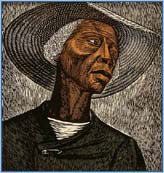
Alma Thomas was an artist inspired by her natural environment. Her paintings are full of vibrant colors and strong brushstrokes. Besides painting professionally, Thomas taught art in the Washington, D.C. schools (yay for art teachers)! Thomas went to Howard University in Washington, D.C. for undergrad and Columbia Teacher’s College for her M.F.A. It was at the age of 55 that Thomas took an abstract painting class and switched from realism to abstract painting focusing on geometric patterns. In 1972 Alma Thomas became the first female African American artist to have a solo exhibition at the Whitney Museum of American Art in New York City.
The Eclipse, 1970
President Obama and First Lady Michelle Obama chose two paintings by Alma Thomas for the White House after President Obama’s first election. More details in the article below.



